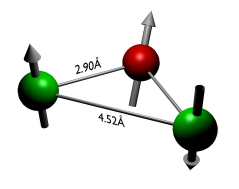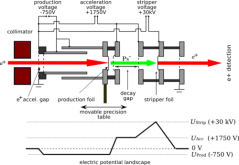MLZ ist eine Kooperation aus:
 > Technische Universität München
> Technische Universität München > Helmholtz-Zentrum Hereon
> Helmholtz-Zentrum Hereon
 > Forschungszentrum Jülich
> Forschungszentrum Jülich
MLZ ist Mitglied in:
 > LENS
> LENS > ERF-AISBL
> ERF-AISBL
MLZ in den sozialen Medien:

MLZ
Lichtenbergstr.1
85748 Garching
Grundlagenforschung mit Positronen
Electron-Positron Pair Plasma
The production and trapping of electron-positron plasmas would enable novel laboratory studies of pair plasmas, which dominated the early Universe during the lepton epoch (few seconds after the big bang), are still found in astrophysical settings and are predicted to have properties significantly different from those of standard electron-ion plasmas. A fundamental challenge is the development of a scheme that allows efficient injection and subsequent confinement of both species.Within the APEX-collaboration (scientists from the Technical University of Munich (TUM) and the Max Planck Institute for Plasma Physics (IPP)) we have succeeded in injecting positrons into a magnetic field trap and confine them for more than a second. We have demonstrated successful injection of positrons in the prototype dipole trap in the presence of an electron space charge. All these results were important steps towards creating a matter-antimatter plasma of electrons and positrons in the lab.
Link to the APEX-collaboration
The Ps Ion – A Leptonic Three Body System
The negative positronium ion Ps– is a bound system consisting of two electrons and a positron.
Its three constituents are point-like leptonic particles of equal mass, which are only subject to the electroweak and the gravitational force.
Hence Ps– is an ideal object to study the quantum mechanics of a three-body systems.
The ground state of Ps– is stable against dissociation but unstable against annihilation into photons.
We report here on a precise measurement of the Ps– ground state decay rate Γ, which was carried out at the high intensity positron source NEPOMUC at the research reactor FRM II in Garching.
A value of Γ = 2.0875(50) ns-1 was obtained, which is three times more precise than previous experiments and in agreement with most recent theoretical predictions.
The achieved experimental precision is at the level of the leading corrections in the theoretical predictions.
Experimental Technique
The beam-foil technique was applied to produce Ps– [Mil90] and a tadem-like setup was used for the detection of Ps–.
The principle of this decay rate measurement is based on the measurement of the amount of surviving Ps– ions as function of their eigen time.
Therefore, Ps– are produced and then drifted with defined energy over a decay gap with variable length.
The intensity of the surviving Ps– ions is measured as a function of the the width of the decay gap d: I ∝ e−μ•d.
Hence the decay rate Γ in the eigen system can be derived from the decay constant μ in the lab system provided that the velocity of the Ps- in known to sufficient accuracy.
The high intense positron beam provided by NEPOMUC is guided onto a DLC foil.
A BGO-scintilation detector is used to measure the incident positron flux.
By passing through the foil the positron loses its energy and subsequently picks up two electrons to form Ps–.
The starting energy of the Ps– ions is limited by the binding energy for the second electron, which is calculated to Eb = 0.326675 eV.
The Ps– ions which emerge from the foil are accelerated in an electric field to their final energy of (Uaccel −Uprod )e = 2500 eV.
After the acceleration the Ps– enters the field-free decay gap.
The length of the gap can be adjusted by a high precision linear positioning stage.
The surviving Ps– , which hurdle the decay gap are further accelerated in a tandem-accelerator-like setup, where the two electron are stripped off the Ps– ion and only the positron remains.
This high energetic (40keV) positron, which serves as a fingerprint for Ps–, is magnetically guided onto a silicon particle detector.
A dipole chicane is used to separate the positron from secondary electrons, which are produced by interactions of the annihilation radiation with the setup.
The count rate of the surviving Ps– ions is measured for a set of different gap distances in order to determine the decay constant μ.
Our present experimental efforts are concentrated on the measurement of the Ps– photo detachment cross-section and the production of a mono-energetic ortho-positronium beam.
The Ps Ion – A Leptonic Three Body System
The negative positronium ion Ps– is a bound system consisting of two electrons and a positron.
Its three constituents are point-like leptonic particles of equal mass, which are only subject to the electroweak and the gravitational force.
Hence Ps– is an ideal object to study the quantum mechanics of a three-body systems.
The ground state of Ps– is stable against dissociation but unstable against annihilation into photons.
We report here on a precise measurement of the Ps– ground state decay rate Γ, which was carried out at the high intensity positron source NEPOMUC at the research reactor FRM II in Garching.
A value of Γ = 2.0875(50) ns-1 was obtained, which is three times more precise than previous experiments and in agreement with most recent theoretical predictions.
The achieved experimental precision is at the level of the leading corrections in the theoretical predictions.
Experimental Technique
The beam-foil technique was applied to produce Ps– [Mil90] and a tadem-like setup was used for the detection of Ps–.
The principle of this decay rate measurement is based on the measurement of the amount of surviving Ps– ions as function of their eigen time.
Therefore, Ps– are produced and then drifted with defined energy over a decay gap with variable length.
The intensity of the surviving Ps– ions is measured as a function of the the width of the decay gap d: I ∝ e−μ•d.
Hence the decay rate Γ in the eigen system can be derived from the decay constant μ in the lab system provided that the velocity of the Ps- in known to sufficient accuracy.
The high intense positron beam provided by NEPOMUC is guided onto a DLC foil.
A BGO-scintilation detector is used to measure the incident positron flux.
By passing through the foil the positron loses its energy and subsequently picks up two electrons to form Ps–.
The starting energy of the Ps– ions is limited by the binding energy for the second electron, which is calculated to Eb = 0.326675 eV.
The Ps– ions which emerge from the foil are accelerated in an electric field to their final energy of (Uaccel −Uprod )e = 2500 eV.
After the acceleration the Ps– enters the field-free decay gap.
The length of the gap can be adjusted by a high precision linear positioning stage.
The surviving Ps– , which hurdle the decay gap are further accelerated in a tandem-accelerator-like setup, where the two electron are stripped off the Ps– ion and only the positron remains.
This high energetic (40keV) positron, which serves as a fingerprint for Ps–, is magnetically guided onto a silicon particle detector.
A dipole chicane is used to separate the positron from secondary electrons, which are produced by interactions of the annihilation radiation with the setup.
The count rate of the surviving Ps– ions is measured for a set of different gap distances in order to determine the decay constant μ.
Our present experimental efforts are concentrated on the measurement of the Ps– photo detachment cross-section and the production of a mono-energetic ortho-positronium beam.
Leiter der Forschungsgruppe
Prof. Dr. Christoph Hugenschmidt
Telefon: +49 (0)89 289-14609
E-Mail: christoph.hugenschmidt@frm2.tum.de
Physik mit Positronen
> Home
> Aktuelles
> Team
> Forschung:
- Positronenstrahlen
- Defektspektroskopie
- Freie Volumina
- Elektronische Struktur
- Oberflächenphysik
- Grundlagenforschung
> Publikationen & Präsentationen
> Lehre
> Galerie
> Funding
> Nützliche Links
MLZ ist eine Kooperation aus:
 > Technische Universität München
> Technische Universität München > Helmholtz-Zentrum Hereon
> Helmholtz-Zentrum Hereon
 > Forschungszentrum Jülich
> Forschungszentrum Jülich
MLZ ist Mitglied in:
 > LENS
> LENS > ERF-AISBL
> ERF-AISBL
MLZ in den sozialen Medien:




